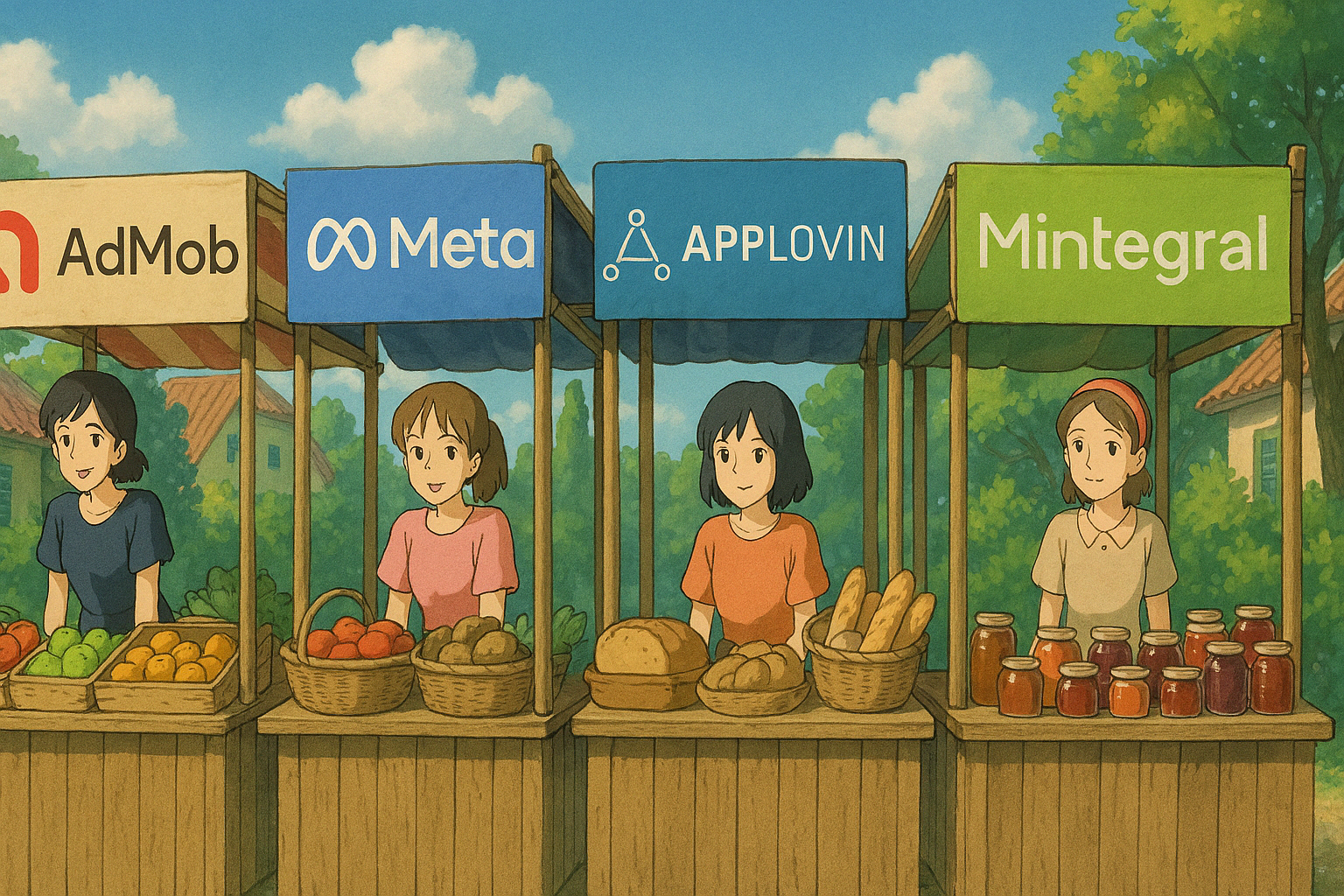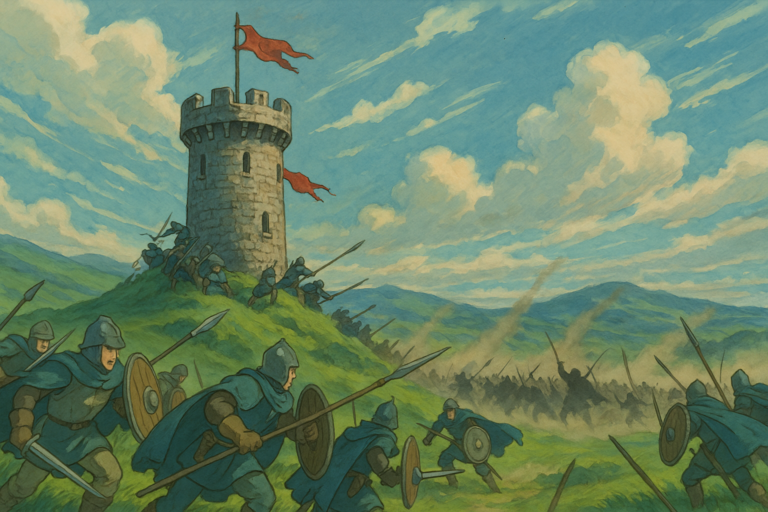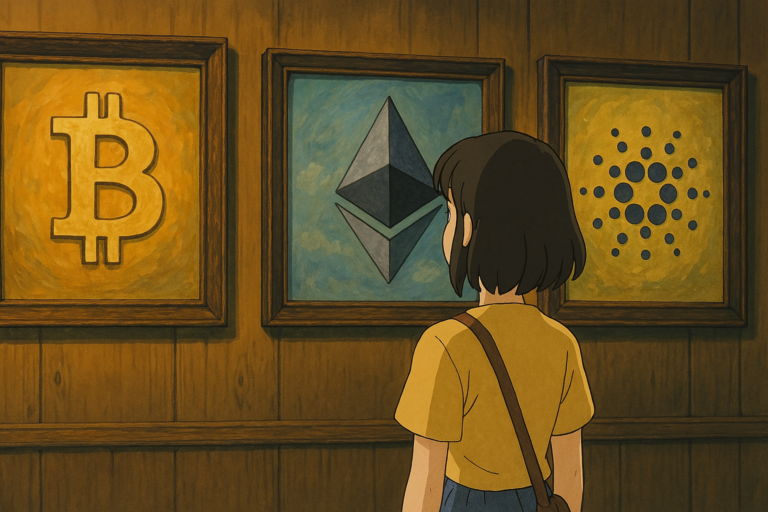Top Ad Networks for Mobile Game User Acquisition (Video Traffic)
Global Overview of Mobile Game UA Networks
Mobile gaming dominates mobile advertising – it makes up about 50% of all user acquisition ad spending worldwide (venturebeat.com). A handful of major ad networks drive the bulk of video ad traffic in mobile games across the globe. In fact, just five networks account for roughly 80–90% of mobile game ad revenue share in early 2024 (tenjin.comtenjin.com). These include AppLovin, Google (AdMob/Google Ads), Unity Ads, Mintegral, and ironSource, with AppLovin and Google alone delivering over half of all game ad volume (tenjin.com). AppLovin leads on iOS with ~37% share, while Google’s AdMob leads on Android with ~28% share(tenjin.comtenjin.com). Other significant players globally are Meta Audience Network (Facebook’s in-app network), TikTok For Business/Pangle, AdColony, Vungle/Liftoff, Chartboost, and InMobi – all of which focus on user acquisition (performance advertising) and serve high volumes of video ads (primarily rewarded videos and video interstitials).
China/HK-based Networks: Among the top networks, a few are based in China or Hong Kong – most notably Mintegral (part of Mobvista) and Pangle (ByteDance’s TikTok-powered ad network). These are similar to Mintegral in origin and focus, offering programmatic UA solutions worldwide. Mintegral has become a dominant player in Asia (even ranking #3 globally on Android by volume in a recent index (mintegral.com)), and Pangle has rapidly grown throughout APAC (globalgamesforum.com). We note these specifically in the comparisons below.
Ad Formats: Virtually all of these networks support video ad formats suited for game monetization and UA, especially rewarded video ads (opt-in ads that reward players) and video interstitials (full-screen video ads). Many also support playable ads or interactive end-cards (mini-game previews) to drive higher engagement. For example, AppLovin, Unity, ironSource, and Mintegral are known for their interactive playable ad experiences in addition to standard video. Most also offer banner or native ads, but the emphasis in mobile game UA is on full-screen video units.
Programmatic & DSP Capabilities: A key trend is that these networks operate with advanced programmatic buying. Many run their own exchanges or bidding platforms, or offer demand-side platform features:
- AppLovin operates the AppLovin Exchange (AAX) and MAX mediation, enabling real-time bidding and programmatic access to its inventory.
- Unity and ironSource (now unified under Unity LevelPlay) use in-app bidding and have large worldwide demand across exchanges (globalgamesforum.com).
- Google’s AdMob supports open bidding and connects with Google Ads’ huge advertiser base programmatically.
- Meta Audience Network leverages Meta’s targeting algorithms (advertisers bid via Facebook’s platform).
- Mintegral is a programmatic platform by design, with AI-driven targeting and cross-regional demand (lancaric.me).
- Pangle similarly is fully bidding-enabled on mediation suites (globalgamesforum.com).
- Networks like AdColony and InMobi have integrated exchanges (AdColony is part of Digital Turbine’s Fyber marketplace; InMobi has its own exchange and DSP).
- Liftoff (Vungle) and Moloco are examples of pure DSPs that buy in-app video inventory at scale – they don’t require SDK integration but bid on supply from these exchanges to acquire users.
Global Traffic Volume: In terms of sheer volume, billions of impressions are transacted through these networks monthly. As of Q1 2024, AppLovin and Google each contributed well over 20% of global mobile game ad impressions (or revenue) (tenjin.com). Unity Ads and Mintegral each held around a 10–15% share, with ironSource a bit smaller (tenjin.com). This shows a fairly consolidated global market. Smaller networks and DSPs make up the remaining ~20% (“Others”) (tenjin.com) – including the likes of AdColony, Chartboost, Vungle/Liftoff, Tapjoy, Moloco, etc. Overall, global UA spend on mobile games is huge (e.g. in H1 2024, game publishers in the US alone spent $650+ million on UA ads (bagelmarketing.com.au)), and these top networks are the primary channels capturing that spend.
Comparative Table of Major Mobile Game UA Ad Networks (Video-Focused)
Below is a comparison of the top user acquisition-focused ad networks buying mobile game video inventory, with their region focus, origins, and capabilities:
| Ad Network | Headquarters | Key Regions | Programmatic/DSP |
|---|---|---|---|
| AppLovin | United States | Global (strong in US/EU, also Asia) | Yes – Exchange (MAX), bidding |
| Google Ads (AdMob) | United States | Global (all regions) | Yes – AdMob in-app bidding, vast DSP demand |
| Unity Ads (LevelPlay) | United States | Global (especially Americas, Europe) | Yes – In-app bidding (Unity LevelPlay) |
| ironSource (LevelPlay) | Israel (now US-owned) | Global (strong in Americas, Europe) | Yes – Real-time bidding (LevelPlay) |
| Meta Audience Network | United States | Primarily North America & Europe (Tier-1 markets)globalgamesforum.com | Yes – Facebook/Meta platform targeting |
| Mintegral | China | Asia-Pacific (dominant in China), growing global (incl. MENA)globalgamesforum.com | Yes – Programmatic UA platform |
| Pangle (TikTok Ads) | China | Asia-Pacific (strong in SEA, East Asia)globalgamesforum.com; limited elsewhere | Yes – In-app bidding enabledglobalgamesforum.com |
| AdColony (Digital Turbine) | United States | North America, Europe; weaker in Tier-2/3 regionsglobalgamesforum.com (MENA etc.) | Yes – Programmatic marketplace (DT Exchange) |
| Liftoff (Vungle) | United States | Global (broad reach via exchange bidding) | Yes – DSP + in-app exchange (Vungle) |
| InMobi | India | APAC (India, Southeast Asia), MENA, some US | Yes – Exchange + DSP (InMobi Audiences) |
| VK Ads (myTarget) | Russia | CIS region (Russia & neighboring CIS) | Limited – primarily closed network (VK ecosystem) |
Table: Top user-acquisition ad networks for mobile games, with region focus and capabilities.
North America (US)
North America (led by the US) is the largest market for mobile game advertising. Unsurprisingly, the top UA networks in the US are the global giants. Google and Meta are typically the biggest sources of mobile app installs by volume – for example, Google Ads and Facebook Ads consistently rank at or near #1 and #2 in various performance indices for installs and retentionblog.udonis.co. However, specialized mobile game networks form an important “gaming triopoly.” Unity Ads, AppLovin, and ironSource (now part of Unity LevelPlay) are deeply entrenched in the US market and drive huge volumes of video ads in games. Unity and ironSource are considered “exceptional for gaming apps” with “huge worldwide demand” behind themglobalgamesforum.com – this holds true in the US where many top-grossing games rely on Unity LevelPlay or AppLovin MAX mediation. AppLovin in particular is a dominant network on iOS and a top 2 on Android by revenue sharetenjin.comtenjin.com.
In addition, Meta Audience Network (the in-app arm of Facebook) and AdColony have strong footing in the US. Meta’s network offers the advantage of Facebook’s advanced targeting, yielding high eCPMs and a full range of formatsglobalgamesforum.com. (It’s worth noting, though, that Meta Audience Network performs best for tier-1 regions like the US; it “reads the room perfectly – but only if you’re in tier-1 markets”globalgamesforum.com.) AdColony, known for its premium video quality, also achieves high fill rates in top-tier markets like the USglobalgamesforum.com.
All of these networks support rewarded videos and video interstitials (the staple formats for game monetization in the US). Playable ads are commonly used in this region as well – for example, AppLovin and IronSource often run interactive playable end-cards to attract quality users. Virtually every major network in NA now transacts via programmatic auctions (in-app bidding). This means UA advertisers can use sophisticated bidding algorithms (or DSPs) to target US gamers at scale. For instance, AdMob and AppLovin enable many DSPs and agencies to bid on US inventory in real time, and Unity’s LevelPlay mediation has most partners in bidding mode.
In summary, North America’s top UA video networks for mobile games are:
- Google Ads/AdMob – massive reach on both Android and iOS in the USventurebeat.com.
- Meta Audience Network – strong performance for gaming in NA (with Facebook’s data).
- Unity Ads & ironSource – (Unity LevelPlay) ubiquitous in games, high volume of rewarded videos.
- AppLovin – huge UA network in NA, particularly effective on iOStenjin.com.
- AdColony – delivers top-notch video ads in the US (and other high-income markets)globalgamesforum.com.
- Vungle/Liftoff – a major video ad network (now part of Liftoff’s DSP) with many US gaming advertisers.
- Apple Search Ads (ASA) – not an in-app network, but worth noting that many US iOS game developers allocate large budgets to ASA for UA on the App Store. (ASA was actually the #1 iOS media source for gaming apps by volume post-ATTappsflyer.com.)
Europe (EU)
Europe is another core region for mobile game advertising, with largely similar network dynamics to North America. The same global UA networks dominate in Europe, though market share is a bit more fragmented. According to Adjust, gaming accounts for ~39% of user acquisition spend in EMEA (Europe, Middle East & Africa)venturebeat.com, slightly lower than in NA – but still the largest vertical. This means UA-focused networks remain extremely active across Europe.
Google and Meta are heavy hitters in EU as well, especially for broad-reach campaigns. In many European countries, Facebook’s Audience Network and Google’s in-app inventory are top sources of game installs. For example, in AppsFlyer’s rankings, Google Ads and Meta Ads were both top-5 media sources for European app installs in 2024blog.udonis.co. Additionally, Unity Ads and AppLovin have a strong presence due to the high number of game developers using their SDKs/mediation in Europe. Unity in particular is popular among European gaming studios (given the Unity engine’s prevalence), making Unity Ads + ironSource (LevelPlay) a go-to for monetization and UA. AppLovin’s network also monetizes many European users and is frequently in the top charts for ROI.
European users see rewarded videos and interstitial videos from the same set of networks (AdMob, Unity, AppLovin, etc.). One difference: regional preferences and regulations (GDPR privacy rules) have pushed networks to refine their targeting – many have adopted contextual targeting and probabilistic models post-privacy changes in Europe. For advertisers, TikTok For Business has emerged as a major channel in EU for video ads (especially for mid-core game UA), but within other games, Pangle (the TikTok Audience Network) still has limited presence in Europe (“Anywhere else? Meh” outside Asiaglobalgamesforum.com). European inventory is more likely filled by Western networks or exchanges.
In summary, the top UA video networks in Europe include Google AdMob/Ads, Meta Audience Network, Unity Ads (LevelPlay), AppLovin, and ironSource, closely followed by AppLovin Exchange DSPs (like Liftoff) and others like AdColony for high-quality video. Mintegral also extends into Europe, but its strength is comparatively lower here than in Asia (Mintegral has “weaker appeal outside of its stronghold regions”globalgamesforum.com). Still, Chinese game advertisers do use Mintegral to acquire European users in certain genres (e.g. puzzle and casual games have notably used AppLovin, Mintegral, and Meta in combinationbagelmarketing.com.au).
Middle East & North Africa (MENA)
The MENA region is a rapidly growing mobile games market, and user acquisition activity is increasing accordingly. While there are few homegrown large-scale ad networks in MENA, global networks actively buy video traffic from MENA-based games. In practice, MENA is served by the same leading networks, with some nuances in performance:
- Google AdMob and Facebook/Meta are widely used to reach MENA audiences, as these platforms have large user bases in the region. Many mobile games advertise through Google’s network and Facebook to target countries like Saudi Arabia, UAE, Egypt, and Turkey (often included in MENA for UA purposes).
- Unity Ads and AppLovin perform well in MENA due to the ubiquity of their SDKs in games. These networks have global campaigns that include MENA geos – for instance, hyper-casual and casual game advertisers often run worldwide campaigns that deliver significant impressions in MENA at relatively lower cost. This ensures high fill rates on Unity and AppLovin even in emerging markets. (By contrast, a network like AdColony that specializes in “top-tier” markets might deliver fewer ads in MENA – AdColony admits “poor performance in tier-2/3 markets”globalgamesforum.com.)
- Mintegral has a notable presence in MENA as well. Many Chinese gaming companies target MENA countries (especially for mid-core and strategy games that are popular there), and Mintegral’s cross-regional capabilities help them acquire users. Mintegral is “dominant in Asia” but also actively acquires users in MENA for those clientsglobalgamesforum.com.
- InMobi (based in India) and Applovin have dedicated efforts in MENA. InMobi’s network extends to Middle East publishers and can bring in video ads from regional advertisers (e.g. e-commerce or local apps), supplementing game ads.
- Pangle (ByteDance) – The TikTok ad network has made some inroads in MENA as TikTok’s popularity soars in the region. However, Pangle remains far more impactful in Asia; outside APAC its demand is modest (“No T1 traffic” outside Asiaglobalgamesforum.com). MENA isn’t a core region for Pangle yet, but we may see growth here with increasing adoption of TikTok ads.
- There are a few local/regional networks (e.g. ArabyAds or AdFalcon) but these are relatively niche for in-app video ads. Most MENA game publishers rely on the major global networks for monetization and thus those are the ones buying their inventory.
In MENA, rewarded videos are extremely popular as a monetization model (many top games in the Middle East use rewarded ads to boost engagement). All the big networks – Google, Unity, AppLovin, Mintegral, etc. – supply rewarded video demand in the region. Playable ads and interactive creatives are used as well (especially by international advertisers localizing their ads for MENA).
In summary, MENA’s top UA networks mirror the global list: Google AdMob, Facebook Audience Network, Unity Ads/ironSource, AppLovin, and Mintegral are key buyers of mobile game video inventory in MENA. The absence of strong local competitors means these global networks have an open field. One report noted that even for fast-growing ad channels in the Middle East, platforms like SHAREit and Digital Turbine (AdColony’s parent) saw increased activitycampaignme.com, reinforcing that international companies drive UA in the region. Overall, advertisers seeking MENA gamers prioritize networks with broad reach and proven performance in similar markets.
CIS (Russia & CIS Countries)
The CIS region (post-Soviet states, including Russia) has a slightly different landscape due to geopolitical factors. Historically, Russia’s mobile ad ecosystem included both global networks and a strong local player, myTarget (Mail.ru Group’s network), which served ads in the VKontakte and Odnoklassniki social platforms as well as in apps. In 2022, Mail.ru rebranded this platform as VK Ads, unifying VK’s ad tools and myTarget into a single systemashmanov.com. VK Ads (formerly myTarget) is now the primary local ad network for user acquisition in Russia/CIS – it connects advertisers to the large user base of VK’s social apps and third-party mobile games. For game UA, VK Ads offers rewarded videos and interstitials inside many popular Russian apps, and it remains a go-to network for reaching CIS users with localized ads.
Global ad networks have had a reduced presence in Russia since 2022. Major Western networks either halted or curtailed operations due to sanctions and business decisions. For example, Google stopped Russian developers from monetizing via AdMob/AdSense in 2022cybernews.com, and Meta’s platforms (Facebook/Instagram) are restricted/banned in Russia. This effectively means Google Ads and Meta Audience Network are largely absent as buyers of Russian mobile game traffic now. In their place, alternative networks and DSPs have stepped up:
- VK Ads (Russia-based) fills much of the demand for Russian inventory, both from local advertisers (e.g. domestic game publishers, banks, services) and some international advertisers still accessing the market.
- Mintegral and other Chinese networks increased their activity. Chinese advertisers and ad platforms did not impose the same restrictions, so Mintegral continues to buy video traffic from CIS games. Many top Russian game publishers report Chinese UA channels as important post-2022.
- Unity Ads and AppLovin – These are US-based, but many CIS-developed games that target global audiences still use Unity/AppLovin for monetization. They can serve ads to CIS users if any advertisers target those users. However, global advertisers (especially from US/EU) often exclude Russia, so fill rates from these networks for Russian-only user traffic might be lower than before. Some mediation platforms allow “run-of-network” ads (e.g. house ads or cross-promotions) to at least show something to Russian users. In non-sanctioned CIS countries (e.g. Kazakhstan, Belarus to some extent), Unity and other networks do still operate, though advertiser demand may be cautious.
- DSPs and programmatic exchanges – A few demand sources (possibly via third-party brokers) still buy Russian mobile impressions programmatically. For instance, some reports indicated Russian firms finding ways to access ad exchanges indirectlyarstechnica.com. But these are not major mainstream channels.
Thus, for CIS region UA, the most active networks are VK Ads (the primary local UA network, akin to a “Russian Facebook Audience Network”), and Mintegral/Chinese networks which are “go-to for Asian markets” and have extended into Russiaglobalgamesforum.com. InMobi and other neutral networks also serve CIS to a degree. Western networks like ironSource, Unity, Applovin still have SDKs in CIS games (and may deliver cross-promotional ads or ads from Asian advertisers), but their direct activity is limited compared to before. Any UA campaigns in CIS now likely lean on VK’s channels or direct deals.
Finally, it’s worth noting that user acquisition in CIS is a smaller slice of global spend (Russia’s economic issues have impacted UA budgets). Many CIS game developers focus on global markets for revenue, so they integrate the usual suspects (Unity, Google, etc.) and thus those networks do buy their video inventory when it’s global traffic. But for targeting users within CIS, the most similar network to Mintegral is indeed Mintegral itself, along with VK Ads, since they are among the few buying video ads in mobile games at high volume in that region post-2022.
Conclusion
In summary, user-acquisition focused ad networks for mobile games are led by a core group of global players – with AppLovin, Google, Unity (LevelPlay), ironSource, Meta Audience Network, and Mintegral at the forefront in 2024–2025. These networks collectively provide the bulk of rewarded video, interstitial video, and playable ad demand in mobile games worldwide. Regionally, their prominence shifts: North America and Europe are dominated by the big US-based networks (plus strong use of Unity/ironSource in gaming); Asia-Pacific sees greater influence from Chinese networks like Pangle and Mintegral; and regions like MENA and LATAM are largely served by the global networks extending their reach. The CIS market relies more on local (VK Ads) and Chinese channels due to geopolitical constraints.
Crucially, programmatic buying capabilities are now standard – meaning advertisers can tap into these networks via DSPs or bidding platforms to acquire users efficiently, and publishers benefit from higher fill rates and competition for their ad slots. The table above provides a quick reference comparing these top networks. Going forward, we can expect the “UA triopoly” of Unity-AppLovin-ironSource to continue evolving (e.g. through mergers and mediation platforms), and Chinese-origin networks to expand further globally, offering alternatives similar to Mintegral. By leveraging a mix of these networks – and tailoring to regional strengths (e.g. using Mintegral/Pangle for Asian markets, VK Ads for Russia, etc.) – game marketers can maximize their user growth through high-volume video advertising channels.
Sources:
- Tenjin Ad Monetization Benchmark, Q1 2024 – global ad network share in mobile gamestenjin.comtenjin.com.
- Gamesforum (Dec 2024) – commentary on top networks (Meta, AdColony, Unity/ironSource, Pangle, Mintegral) and their regional strengths/weaknessesglobalgamesforum.comglobalgamesforum.comglobalgamesforum.comglobalgamesforum.com.
- Adjust/VentureBeat (2021) – share of UA spending by region (gaming 50% of UA spend globally; 57% in NA, 39% in EMEA)venturebeat.com.
- Bagelmarketing/SensorTower (2024) – noted puzzle/casual game advertisers favor AppLovin, Mintegral, Unity, etc., and evenly distribute spend across top platformsbagelmarketing.com.aubagelmarketing.com.au.
- AppsFlyer Performance Index 2024 – rankings of top media sources for gaming UA (Google, Meta, Unity, AppLovin, TikTok, Mintegral, etc.)blog.udonis.co.
- VK Ads integration note – VK Ads (myTarget) as the unified Russian ad platformashmanov.com.
- News reports – e.g. Google and Meta’s restrictions in Russiacybernews.com.





